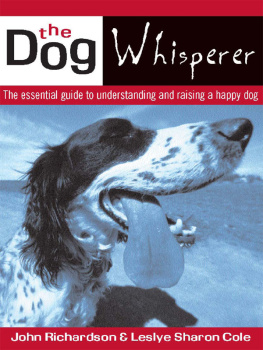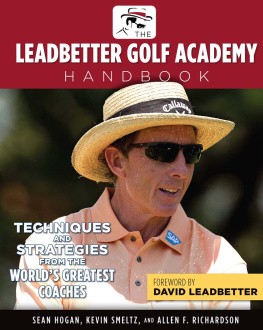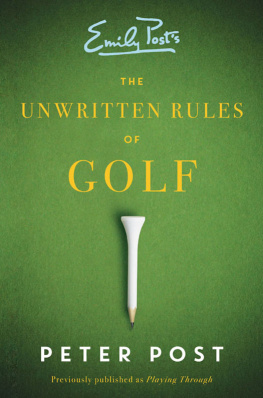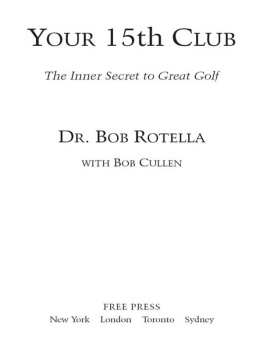John Richardson worked for more than fifteen years in the coffee-bar and restaurant industry, at one time running the largest sandwich business in Ireland. He used this experience to write Wake Up and Smell the Profit: 52 Guaranteed Ways to Make More Money in Your Coffee Business and The Coffee Boys Step-by-Step Guide to Setting Up and Managing Your Own Coffee Bar . He lives with his wife and daughter in Bangor, Northern Ireland. A keen golfer, he is also the author of the bestselling book Dream On: One Hackers Challenge to Break Par in a Year (Skyhorse Publishing, 2010).

First Skyhorse Publishing edition 2015
All rights to any and all materials in copyright owned by the publisher are strictly reserved by the publisher.
All rights reserved. No part of this book may be reproduced in any manner without the express written consent of the publisher, except in the case of brief excerpts in critical reviews or articles. All inquiries should be addressed to Skyhorse Publishing, 307 West 36th Street, 11th Floor, New York, NY 10018.
Skyhorse Publishing books may be purchased in bulk at special discounts for sales promotion, corporate gifts, fund-raising, or educational purposes. Special editions can also be created to specifications. For details, contact the Special Sales Department, Skyhorse Publishing, 307 West 36th Street, 11th Floor, New York, NY 10018 or .
Skyhorse and Skyhorse Publishing are registered trademarks of Skyhorse Publishing, Inc., a Delaware corporation.
Visit our website at www.skyhorsepublishing.com.
10 9 8 7 6 5 4 3 2 1
Library of Congress Cataloging-in-Publication Data is available on file.
Cover design by Richard Rossiter
Print ISBN: 978-1-63450-453-9
Ebook ISBN: 978-1-63450-471-3
Printed in the United States of America
For every amateur golfer still searching for the secret...
CONTENTS
Video content
Golf instruction is tricky at the best of times but attempting to use just the written word can be the most confusing form of instruction of all.
To lessen this confusion we have created a video to accompany each tip and these can be found at:
www.fiftygreatgolftips.com
Youll also get to see a few of the tips that missed the cut as well as a broader explanation of the seven-step process for golf improvement.
Introduction
Im not a professional golfer, Ive never played in a Ryder Cup, and sadly I havent joined the ranks of those Northern Irish golfers who have bagged a major or two. What I am is an average amateur golfer who managed to make a very un-average improvement to my golf in a relatively short period of time. During that time I came pretty close to trying every golf tip out there and had varying levels of success. These days, after a relatively long career owning my own businesses, I operate as a business consultant to a very large range of enterprises.
So, as both a golfer and a business consultant, Im obsessed with finding tips, techniques, strategies, or ideas that actually work. Tips that the average golfer can use. Not a Rory, Darren, Graeme, or Padraig, but a time-starved, cash-limited, and possibly creaky-backed golfer like the rest of us.
A few years ago I embarked on a challenge that, for better or worse, was deemed impossible by the golfing community at every level. When asked about my chances, Ryder Cup legend Sam Torrance told me to dream on, and Darren Clarke suggested that three years was the shortest possible timeline for what I was attempting to do. When I ventured into the Wild West of the internet golf forums to post about my challenge I encountered everything from friendly scepticism to extreme and hilariously personal abuse.
The challenge was pretty simple. My aim was to change from being a golfer who couldnt break par to being one who could shoot a level par round or better within a year, while holding down a fifty-hour-a-week job. I had a full 365 days to take my control round of 103 down to 71 or better. I decided to attempt this at the Blackwood Golf Centre, my local course in Bangor, County Down, in large part because it was a 6,300-yard, par seventy-one course, with an additional, and challenging, par three course and a high-quality driving range. I also had a good relationship with the managers of the center, having previously managed the bar and catering facilities.
During that year I hit over seventy thousand golf balls in practice, watched dozens of DVDs, YouTube posts, and old videos, read over sixty books (and countless magazine articles) on golf improvement, and had some great, albeit brief, conversations with some truly great golfers. I picked up some exceptional tips and these had a substantial and quantifiable effect on my progress. To cut a very long story short, after some epic highs and multiple humiliating lows, I eventually managed, 362 days after I had started, to shoot a 70 at Blackwoodone under par.
The full story of my challenge can be found in my book Dream On: One Hackers Challenge to Break Par in a Year. Sam Torrance may have doubted my ability to shoot a par round but he certainly provided me with a great title for the book!
But perhaps of more interest to you is what Ive done with my golf subsequently. Golf is a sport that gets under your skin, so, since I finished the challenge, I have continued to study the ways that golfers improve. I set up a business called the Break Par Blueprint which has now worked with more than three thousand golfers to help them produce tangible and rapid improvement.
I have also had the opportunity to speak to some of the best coaches and players in the world, and while this has been a wonderful journey it has also made me realize just how confusing and conflicting golfing advice can be. Golfers, like the rest of mankind, are obsessed with immediate gratification and the promise of instant results. We have a tendency to believe that Ben Hogan really did find the secret and barely a year passes without some new book purporting to have discovered it, whilst conveniently explaining that all previous discoveries were wrong.
This book is different in that it brings together the very best tips that I have discoveredtips that can help you to make real progress. Its about sorting the wheat from the chaff and showing what has really worked, not just for me, but also for the many golfers I have worked with, spoken to, played with, and read about.
A word of cautionby their nature, in many cases tips provide Band-Aids to problems that have developed over time rather than help you look at your game as a whole and see how your scoring can be improved in a more holistic fashion. Im aware how irritating that word is, but in this case Im not talking about weird alternative therapies. Im taking about looking at all the aspects of your golf game, considering the way they interact, and then coming up with a plan for improvement. In very few cases, you may just need a few excellent tips or drills but very often what you think you need to improve is not what is necessary for long-term improvement.
The second thorny issue is that there will always be different opinions on what will fix different problems. I once played a round of golf with the editor of one of the largest golf magazines in the world and he talked about how most editions of the magazine contained conflicting advice from different coaches or players. Rather than attempting to persuade the contributors to alter their tips, they positioned them as far apart in the magazine as possible in the hope that readers wouldnt notice!
So the point really is that you should take the tips in this book, however good they may be, within the context of the fact that they can be occasionally conflicting and must ideally be part of a structured long-term golf improvement process.
Next page













